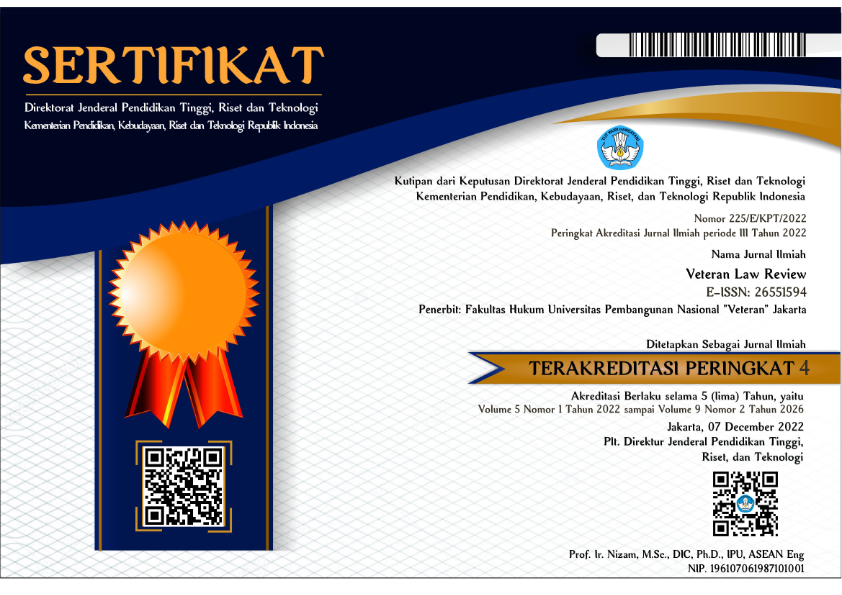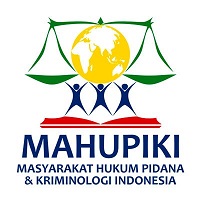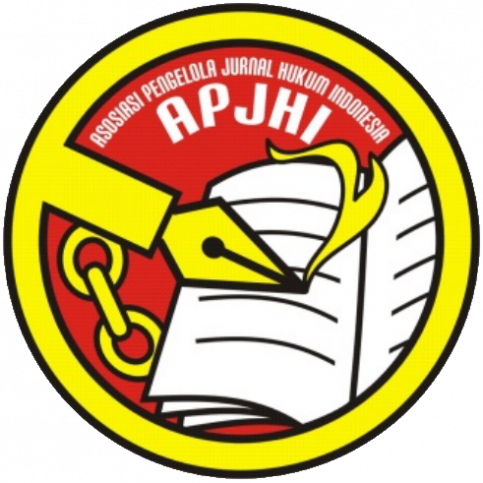Protection of Communal Intellectual Property Rights Through Geographical Indication System
DOI:
https://doi.org/10.35586/velrev.v5i2.4512Keywords:
Intellectual Property Rights, Communal, Geographical IndicationAbstract
This study aims to protect the original product/goods related to geographical conditions due to natural and/or human factors to be registered for protection through a Geographical Indication system that can be owned by the community communally. The research method used is normative juridical using secondary data. The law can be one of the tools to protect the regime of Geographical Indications by way of registration as regulated in Law Number 20 of 2016 concerning Marks and Geographical Indications. Article 53 reads: "Geographical Indications are protected after Geographical Indications are registered by the Minister". The main function of law is to protect the interests that exist in society. According to Roscou Pound, there are three interests that must be protected by law, namely: public interest, individual interest and interest of personality. Although most intellectual property rights protect individual property rights and individual interests, geographical indications are one that can be categorized as communal property rights.
Downloads
References
Books:
Ahmad Ramli, Miranda Risang Ayu Palar, and the Research Team, Intellectual Property Law (Geographical Indications and Tradition Wealth in Theory and Practice), First Edition, Bandung: PT Refika Aditama.
Landes, WM, & Posner, RA, (2003), The Economic Structure of Intellectual Property Law. Harvard University Press.
Irene Calboli And Wee Loon Ng-Loy, (2017), Eds, Geographical Indications at The Crossroads of Trade, Development, And Culture, Cambridge University Press.
Talib, A, (2016), Thoughts on Business Law and State Administration in Indonesia: Intellectual Property Rights in National Development, Pekanbaru: Unilak Press Thing.
Journals:
Apriansyah, N, “Protection of Geographical Indications Within the Scope of Improvement of Regional Economy”, De Jure Journal of Legal Research, Vol 18, No 4, (2018).
Ayu Palar, MR, Ramli, AM, Sukarsa, DE, Dewi, IC, & Septiono, S, “Geographical Indication Protection for Non-Agricultural Products in Indonesia”, Journal Of Intellectual Property Law & Practice, Vol 16, No 4-5, (2021): 405-414.
Djaja, H, “Protection of Geographical Indications on Local Products in the International Trade System”, Journal of the Horizon of Law, Vol 18, No 2, (2013).
Effida, DQ, “Juridical Review of Geographical Indications as Non-Individual (Communal) Intellectual Property Rights”, Ius Civile: Reflections on Law Enforcement and Justice, Vol 3, No 2, (2019).
Eman. Suparman, "Harmonization of Law in the Global Era Through Nationalization of Transnational Rules", Syiar Hukum, Vol 11, No 3, (2009): 245-262.
Huala, Adolf, "Trade-Related Aspects Of Intellectual Property Rights And Developing Countries", The Developing Economies, Vol 39, No 1, (2001): 49-84.
Joesoef, I. E, “The Existence of Adat Law Related to Land Right Transaction After Unification Of Indonesian Agrarian Law: The Problem Of Legal Transplant”, Veteran Law Review, Vol 1, No 1, (2018): 20-31.
Miranda Risang Ayu Palar, Et. Al, "Indonesian System of Geographical Indications to Protect Genetic Resources, Traditional Knowledge and Traditional Cultural Expressions", Journal Of Intellectual Property Rights, Vol 23, (2018): 174-193.
Miranda Risang Ayu Palar, etc, “Environmental Sustainability and GI Protection in Indonesia”, Presentation About GI At 4th IPIRA Conference, (2022): 9-12.
Nasution, A. I, “The Changes Impact on State Ministries Nomenclature Toward National Development Progress”, Veteran Law Review, Vol 4, No 2, (2021): 94-108.
Nugraha, YA, & Haryanto, I, “Obstacles to Registration of Geographical Indications of Sumedang Tofu as a Regional Potential Asset”, Justice, Vol 18, No 1, (2020): 1-19.
Oktavinanda, PA, “Legal Positivism and Law and Economics--A Defense”, In Third Indonesian National Conference of Legal Philosophy, (2013), August, PP 27-28.
Sudjana, S, “Implications of Protection of Geographical Indications Based on Law Number 20 of 2016 on Local Economic Development”, Veritas Et Justitia, Vol 4, No 1, (2018): 30-58.
Yessiningrum, WR, “Legal Protection of Geographical Indications as Part of Intellectual Property Rights”, IUS Journal of Legal and Justice Studies, Vol 3, No 1, (2015).
Laws and Regulations:
Law Number 20 of 2016 concerning Marks and Geographical Indications, Government Regulation Number 51 of 2007 concerning Geographical Indications, Minister of Law, and Human Rights Regulation Number 12 of 2019 concerning Geographical Indications and The Related Aspects of Intellectual Property Rights (TRIPs Agreement).
Website Material:
Purba, AZU, & Zen, A, (2005), International Regulation on Geographical Indications, Genetic Resources, And Traditional Knowledge. In Workshop on The Developing Countries Interest to Geographical Indications, Genetic and Traditional Knowledge, PIH FHUI And Dit. Gen Of IPR's, Dept. Of Law and Human Rights, RI, Jakarta.
Rahmah, M, (2017), Industrial Property Rights Protection of Geographical Indications for Agricultural Products: Scenarios to Support Food Security.
Saky Septiono, (2009), Protection of Geographical Indications and Potential Geographical Indications of Indonesia, Sub-Directorate of Geographical Indications of the Directorate General of Intellectual Property Rights, Ministry of Law and Human Rights of the Republic of Indonesia.
Susiana, S. (Ed.), (2015), Sustainable Development: Social, Economic, And Environmental Dimensions, P3DI Secretariat General of the DPR.
Manullang, EFM (2017). Overview: The Legal System in Indonesia. date.
Mukti Fajar, ND, & Achmad, Y, (2010), The dualism of Legal Research: Normative & Empirical, Student Library.
Purba, B., Sudarmanto, E., Syafii, A., Nugraha, NA, Zaman, N., Ahdiyat, M., & Umarama, A, (2020), Political Economy: Theory and Thought, Our Writing Foundation.
WIPO, (2021), World Intellectual Property Indicators 2021, Geneva: World Intellectual Property from https//www.wipo.int/edocs/pubdocs/En/Wipo_Pub_941_2021.Pdf
Downloads
Published
How to Cite
Issue
Section
License
Copyright (c) 2022 Veteran Law Review Journal
Veteran Law Review © 2022 by Faculty of Law Universitas Pembangunan Nasional "Veteran" Jakarta is licensed under Creative Commons Attribution 4.0 International

1. License
The non-commercial use of the article will be governed by the Creative Commons Attribution license as currently displayed on Creative Commons Attribution 4.0 International.
2. Author(s)' Warranties
The author warrants that the article is original, written by the stated author(s), has not been published before, contains no unlawful statements, does not infringe the rights of others, is subject to copyright that is vested exclusively in the author, and free of any third party rights, and that any necessary written permissions to quote from other sources have been obtained by the author(s).
3. User/Public Rights
VELREV's spirit is to disseminate articles published are as free as possible. Under the Creative Commons Attribution-ShareAlike 4.0 International License. VELREV permits users to copy, distribute, display, and perform the work for non-commercial purposes only. Users will also need to attribute authors and VELREV to distributing works in the journal and other media of publications.
4. Rights of Authors
Authors retain all their rights to the published works, such as (but not limited to) the following rights;
- Reproduce the work
- Prepare derivative works based upon the work
- Distribute copies of the work
- Perform the work publicly
- Display the work publicly
- Copyright and other proprietary rights relating to the article, such as patent rights,
- The right to self-archive the article,
- The right to enter into separate, additional contractual arrangements for the non-exclusive distribution of the article's published version (e.g., post it to an institutional repository or publish it in a book), with an acknowledgement of its initial publication in this journal (Veteran Law Review).
5. Co-Authorship
If the article was jointly prepared by more than one author, any author submitting the manuscript warrants that he/she has been authorized by all co-authors to be agreed on this copyright and license notice (agreement) on their behalf, and agrees to inform his/her co-authors of the terms of this policy. VELREV will not be held liable for anything that may arise due to the author's internal dispute. VELREV will only communicate with the corresponding author.
6. Royalties
Being an open accessed journal and disseminating articles for free under the Creative Commons license term mentioned, author(s) are aware that VELREV entitles the author(s) to no royalties or other fees.
7. Miscellaneous
VELREV will publish the article (or have it published) in the journal if the article’s editorial process is successfully completed. JOSI's editors may modify the article to a style of punctuation, spelling, capitalization, referencing, and usage that deems appropriate. The author acknowledges that the article may be published so that it will be publicly accessible and such access will be free of charge for the readers as mentioned in point 3.


















